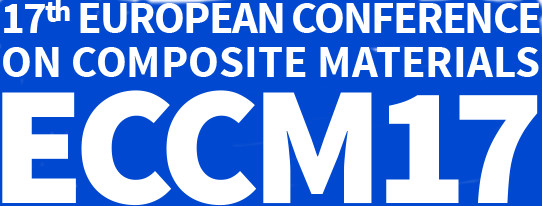

App-Einstellungen:
MODELLING THE TENSILE FAILURE OF HYBRID POLYMER COMPOSITES
Rodrigo Tavares (Faculdade de Engenharia da Universidade do Porto) António Melro (University of Bristol) Albert Turon (AMADE, Universidad de Girona) Pedro Camanho (University of Porto)
A micromechanical model that takes into account the statistical nature of fibre strength and the proper constitutive response of the matrix and fibre-matrix interface is developed to study the tensile failure of hybrid and non-hybrid composites.
PREDICTION OF MECHANICAL PROPERTIES OF HYBRID DISCONTINUOUS COMPOSITES
Joel Henry (Imperial College London) Soraia Pimenta (Imperial College London) HaNa Yu (University of Bristol) Marco Luigi Longana (University of Bristol)
A non-linear stress-strain response is predicted with an analytical model coupling shear-lag of the matrix with fibre strength variability. The model was validated experimentally, and captures hybrid effects in the material’s stiffness and strength.
REPEATED LOW ENERGY IMPACT BEHAVIOUR OF SELF-REINFORCED POLYPROPYLENE FIBRE METAL LAMINATES
Laurentzi Aretxabaleta (Mondragon Unibertsitatea) Joseba Iñaki Múgica (Mondragon Unibertsitatea) Modesto Mateos (Mondragon Unibertsitatea) Jon Aurrekoetxea (Mondragon Unibertsitatea)
In this study the impact-fatigue behaviour of a polypropylene SRFML has been characterized by drop weight impact tests at impact energies of 20, 15, 13, 10 and 8J. The main dissipation damage mechanisms of the material have been identified.
EVALUATION OF ALUMINA AS PROTECTIVE COATING FOR CARBON FIBERS IN ALUMINUM-BASED COMPOSITES
Mario Krug (Fraunhofer IKTS) Alfaferi Zainal Abidin (Fraunhofer IKTS) Mandy Höhn (Fraunhofer IKTS) Piotr Malczyk (Technical University of Dresden) Ingolf Endler (Fraunhofer IKTS) Alexander Michaelis (Fraunhofer IKTS)
Al2O3-coated textile preforms infiltrated with 239D were dense with very low residual porosity. Alumina layer works properly to improve wettability with 239D-melt. But the alumina layer degrades by the reaction with the alloy component Mg.
HYBRID SOL-GEL THIN FILMS WITH ALUMINA NANOPARTICLES WITH HYDROPHOBIC PROPERTIES
Francisco Carreño (Universidad Complutense de Madrid) Oscar Rodriguez (Universidad Complutense de Madrid) Noemi Carmona (Universidad Complutense de Madrid)
We have prepared hybrid silica-alkylsiloxane thin films. Samples have been characterized by scanning electron microscopy and water contact angle measurements. The results show a 130º water contact angle for the ‘up to date’ best set of parameters.
NEWS INDICATORS FOR THE DAMAGE EVOLUTION AT HIGH TEMPERATURE UNDER AIR OF A SIC/[SI-B-C] COMPOSITE SUBJECTED TO CYCLIC AND STATIC LOADING
Elie Racle (INSA de Lyon) Nathalie Godin (INSA de Lyon) Pascal Reynaud (INSA de Lyon) Mohamed R'Mili (INSA de Lyon) Gilbert Fantozzi (INSA de Lyon) Carole Rakotoarisoa (Snecma) Florent Bouillon (Herakles (SAFRAN)) Myriam Kaminski (ONERA-The French aerospace Lab)
Different approaches based on acoustic emission are developped to quantify damage along the fatigue tests. New indicators of damage based on acoustic energy highlight critical times allowing an evaluation of the remaining lifetime.
SYNTHESIZING CONDITIONS AND STRUCTURAL-PHASE STATE OF TI-NB ALLOY WHEN SELECTIVE LASER MELTING
Alexander Saprykin (National Research Tomsk Polytechnic University) Yu. P. Sharkeev (Institute of Strength Physics and Material Science of Siberian Branch Russian Academy of Sciences) E. A. Ibragimov (Yurga Institute of Technology) E. V. Babakova (Yurga Institute of Technology) Zhanna G. Kovalevskaya (Institute of Strength Physics and Material Science of Siberian Branch Russian Academy of Sciences) A. Yu. Eroshenko (Institute of Strength Physics and Material Science of Siberian Branch Russian Academy of Sciences) Margarita Khimich (Institute of Strength Physics and Material Science of Siberian Branch Russian Academy of Sciences) P. V. Uvarkin (Institute of Strength Physics and Material Science of Siberian Branch Russian Academy of Sciences) I. A. Gluhov (Institute of Strength Physics and Material Science of Siberian Branch Russian Academy of Sciences)
A searching experiment aimed at identifying appropriate process conditions to form single tracks of titanium and niobium composite powder is reported to be carried out by an SLM experimental facility.
TUNGSTEN FIBRE-REINFORCED TUNGSTEN COMPOSITE – DEVELOPMENT OF A NEW HIGH PERFORMANCE MATERIAL
Johann Riesch (Max-Planck-Institut für Plasmaphysik) Jan W. Coenen (Forschungszentrum Jülich GmbH) Hanns Gietl (Max-Planck-Institut für Plasmaphysik) Till Höschen (Max-Planck-Institut für Plasmaphysik) Yiran Mao (Forschungszentrum Jülich GmbH) Christian Linsmeier (Forschungszentrum Jülich GmbH) Rudolf Neu (Max-Planck-Institut für Plasmaphysik)
Overview of the development, manufacturing and characteristics of tungsten fibre-reinforced composites anticipated for the use in a future fusion reactor and possibly in other highly loaded structures.
CHANGES IN FIRST-PLY-FAILURE MODE OF THERMALLY DEGRADED CFRP
Johannes Wolfrum (Bundeswehr research institute for materials, fuels and lubricants (WIWeB)) E. Quan (Bundeswehr research institute for materials, fuels and lubricants (WIWeB)) G. Maier (Bundeswehr research institute for materials, fuels and lubricants (WIWeB))
The goal of these investigations was to observe the onset of crack propagation of increasingly thermally degraded CFRP under tensile loading by using AE analysis. Thermal degradation was interpreted microscopically and by µ-ATR-FTIR spectroscopy.
INFLUENCE OF WATER ON THE CYCLIC BEHAVIOUR OF A WOVEN GLASS/PA6,6 COMPOSITE
Amélie Malpot (Institute Pprime ) Fabienne Touchard (P' Institute) Sébastien Bergamo (Renault)
This study deals with the influence of moisture content on the fatigue behaviour of a woven glass fibre reinforced PA6,6 composite. A fatigue life model is developed in order to predict the fatigue life of this material in any moisture configuration.
